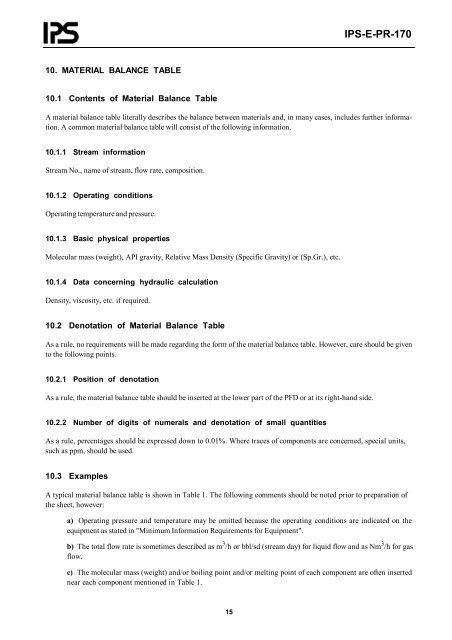engineering standard for process flow diagram
engineering standard for process flow diagram
engineering standard for process flow diagram
- No tags were found...
Create successful ePaper yourself
Turn your PDF publications into a flip-book with our unique Google optimized e-Paper software.
IPS-E-PR-17010. MATERIAL BALANCE TABLE10.1 Contents of Material Balance TableA material balance table literally describes the balance between materials and, in many cases, includes further in<strong>for</strong>mation.A common material balance table will consist of the following in<strong>for</strong>mation.10.1.1 Stream in<strong>for</strong>mationStream No., name of stream, <strong>flow</strong> rate, composition.10.1.2 Operating conditionsOperating temperature and pressure.10.1.3 Basic physical propertiesMolecular mass (weight), API gravity, Relative Mass Density (Specific Gravity) or (Sp.Gr.), etc.10.1.4 Data concerning hydraulic calculationDensity, viscosity, etc. if required.10.2 Denotation of Material Balance TableAs a rule, no requirements will be made regarding the <strong>for</strong>m of the material balance table. However, care should be givento the following points.10.2.1 Position of denotationAs a rule, the material balance table should be inserted at the lower part of the PFD or at its right-hand side.10.2.2 Number of digits of numerals and denotation of small quantitiesAs a rule, percentages should be expressed down to 0.01%. Where traces of components are concerned, special units,such as ppm, should be used.10.3 ExamplesA typical material balance table is shown in Table 1. The following comments should be noted prior to preparation ofthe sheet, however:a) Operating pressure and temperature may be omitted because the operating conditions are indicated on theequipment as stated in "Minimum In<strong>for</strong>mation Requirements <strong>for</strong> Equipment".b) The total <strong>flow</strong> rate is sometimes described as m 3 /h or bbl/sd (stream day) <strong>for</strong> liquid <strong>flow</strong> and as Nm 3 /h <strong>for</strong> gas<strong>flow</strong>.c) The molecular mass (weight) and/or boiling point and/or melting point of each component are often insertednear each component mentioned in Table 1.15
















